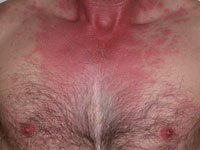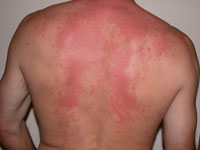
Have you ever looked like this after eating fish? Or this?

This is histamine fish poisoning, a common toxicity related to eating fish, after this man ate tuna. 40% of seafood-related food-borne illnesses reported each year are due to histamine fish poisoning. This is different than an allergic reaction. What causes this?
Patients are traveling this summer to the islands - Long Island, Staten Island, City Island and down to the shore. They want a relaxing time away from the daily grind. Most like to enjoy a fresh seafood dinner with the local catch. Make sure your seafood supplier gets a fresh catch and properly stores the fish on ice; otherwise, you might end up in the ER with histamine poisoning.
Histamine fish poisoning looks like an allergic reaction, but it is actually caused by bacteria generated toxins in the fish's tissues. If you eat an inadequately preserved cerviche or improperly refrigerated fish you can experience histamine fish poisoning.
This used to be called mahi-mahi flush or scombroid fish poisoning. Scombridae or dark meat fish is Greek for scombros which means mackerel or tunny. Implicated fish are mackerel, tuna, marlin, swordfish, albacore, bonito, skipjack, herring, sardines, anchovy, bluefish and 100 other species. Fish from tropical waters are more likely to be involved in outbreaks, but histamine fish toxicity is worldwide and affects people of all ages, races and genders. If you're traveling to the tropics this summer be aware of your environment.
The typical presentation of histamine fish poisoning is skin flushing on the upper body, G.I. complaints and a throbbing headache. To confirm the diagnosis you can measure histamine levels in the patient's urine and test histamine levels in the uneaten portions of the suspected fish. I guess you can ask for that fish to go straight to the tox lab. No doggy bags; get something they would use on CSI.
Alittle CSI pathophysiology science to impress your friends at your next fish BBQ
Improper preservation or refrigeration causes histidine decarboxylase or HDC in certain pathogens to convert histidine present in fish tissue into histamine. Without refrigeration, the bacteria multiply, increase the conversion of histidine to histamine and raise histamine levels where they reach toxic levels within 12 hours. There may be a second agent at work; saurine that enhances histamine absorption or cadaverine or putrescine. We don't know for sure. Enzymes get knocked out and bacterial loads proliferate. It's all very dramatic and even more dramatic when your body experiences a systemic reaction.
The key to this problem is previous inadequate refrigeration because cooking, smoking or canning the fish does not eliminate the histamine that is built up. Fish has to be chilled immediately after being caught and you want to keep it at an internal temperature of 50 degrees F within 6 hours of the fish's death. Ambient storage temperature should be below 40 degrees F during the entire handling process.
High histamine fish don't look different or smell fishy. The fish might look honeycombed and fish with high histamine concentrations might taste pungent or peppery. If your fish tastes bitter or peppery stop eating it. If you just cracked fresh pepper on your dish - how could you tell? You can't. To make matters worse, bacterial contamination occurs unevenly in fish so you could eat one part with no effects and a different bite might be loaded with histamines. Size and spot of the portion consumed makes all the difference. Some individuals are genetically sensitive to or cannot metabolize histamine because they are lacking or missing an enzyme. I prescribe this enzyme to many of my patients who have poor gut function and impaired enzyme pathways. Second Nature patients take Xymogen's HistDao with every meal to prevent histamine dumping and allergic reactions from foods. This treatment is absolutely brilliant. It works. I travel with two bottles of HistDao where ever I go.
For generalized inflammation I prescribe DFH's Inflammatone with several doses per day as per needed.
What are the symptoms and how soon do they appear?
Symptoms present within 15-60 minutes of eating the fish. Manifestations include:
-
Erythema of the face, neck, and upper torso (redness)
-
Headache (severe and throbbing)
-
Dysphagia (difficulty swallowing)
-
Nausea and vomiting
-
Abdominal cramps or epigastric pain
-
Diarrhea
-
Palpitations
-
Pruritus (non-stop itching)
-
Dizziness
-
Dry mouth
-
Angioedema (swelling in your subcutaneous tissues: lips, face; if your throat swells and blocks your breathing this is serious)
-
Sense of anxiety or unease (I'd be anxious)
-
Respiratory distress and chest tightness (rare)
-
Loss of vision (rare) (then you're really lost at sea)
Will I live? Yes, patients with histamine fish toxicity have a good prognosis. Involvement is rapid and complications are rare. Some complications are serious and include: bronchospasm, angioedema, hypotension, pulmonary edema and cardiogenic shock. So, if you can't breathe, you're swelling up in your face and upper body, your blood pressure drops and your lungs are filling with fluid or your heart stops these require immediate medical attention, but otherwise don't worry.
Related blog:



